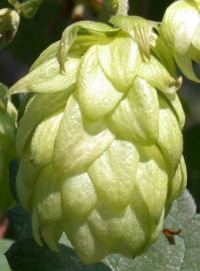|
Pollach, G.; Hein, W.; Rösner, G.:
New findings towards solving microbial problems in sugar factories. Zuckerindustrie 124 (1999) pp. 622-637. |
 Abstract: This paper contributes to the existing body of knowledge on microbiology of beet extraction and thick juice storage, including new measures against micro-organisms. A striking parallelism between nitrite limitation and and acetic acid limitation in full-scale trials in which hop beta acids were used led to laboratory trials, which showed that acetic acid was formed during nitrite formation. Further trials, which are important for pulp ensiling, showed a switch-over from an unwanted butyric acid formation to lactic acid formation on continuous dosage of hop beta acids to press water. The authors point to successful trials abroad, with full suppression of micro-organisms, because rather high bacterial levels are necessary to run Austrian factories. During the last campaign, the suppression of micro-organisms was improved with a new hop product
BetaStab®10
A, based on an alkaline solution. New investigations on the fate of hop beta acids showed a low carry-over of 25% of hop beta acids from extraction towers to the raw juice. With improved sensitive methods, white sugar samples showed low values of 0.02 mg/kg of hop beta acids.
Abstract: This paper contributes to the existing body of knowledge on microbiology of beet extraction and thick juice storage, including new measures against micro-organisms. A striking parallelism between nitrite limitation and and acetic acid limitation in full-scale trials in which hop beta acids were used led to laboratory trials, which showed that acetic acid was formed during nitrite formation. Further trials, which are important for pulp ensiling, showed a switch-over from an unwanted butyric acid formation to lactic acid formation on continuous dosage of hop beta acids to press water. The authors point to successful trials abroad, with full suppression of micro-organisms, because rather high bacterial levels are necessary to run Austrian factories. During the last campaign, the suppression of micro-organisms was improved with a new hop product
BetaStab®10
A, based on an alkaline solution. New investigations on the fate of hop beta acids showed a low carry-over of 25% of hop beta acids from extraction towers to the raw juice. With improved sensitive methods, white sugar samples showed low values of 0.02 mg/kg of hop beta acids. As to thick juice storage, hop products were not successful as a surface treatment. Thus, treatment with caustic soda solution is recommended instead of a possible formalin application. Independent of the surface, the first positive results were obtained with hop beta acids applications to the bulk of the thick juice as a means of controlling bacterial activity there. |
|
Hein, W.; Pollach, G.:
New findings with the use of hop products in the sugar industry (German). Zuckerindustrie 122 (1997) pp. 940-949. |
|
Abstract: During the 1996 beet campaign hop base extract was again used in several factories in full plant scale to reduce bacterial activity in sugar beet extraction. By dosing hop base extract periodically at mid tower position in amounts of 10 g per ton of beet, the lactic acid content of raw juice was reduced to 400 mg/kg raw juice, without severe influence on the fermentation in the upper part of the tower. The dry substance of pressed pulp was increased to 30% by a residual fermentation. Rapid dosing with high actual concentration, as well known from formalin, is also advantageous for hop extract. Existing devices in Austrian factories must be improved accordingly in the future. In an aerobic trough diffuser with rather low presswater temperatures it was necessary to use 25 g hop base extract per ton of beet to achieve a similar residual lactic acid concentration. Under these temperature conditions only formalin was able to inhibit bacterial activity completely. In contrast to the reduction of lactic acid, especially nitrite formation could be avoided, and acetic acid formation which is typical of aerobic extraction equipment was largely reduced. In case of acetic acid and nitrite, base axtract was more effective than a combination of a dithiocarbamate product, a iodophore product and chlorite of lime. Investigations on the fate of hop extracts showed that values in the products sugar, molasses and pulp are undetectable or uncritical, even under shock-dosing conditions. |
|
Pollach, G.; Hein, W.; Hollaus, F.:
Use of hop products as bacteriostaticum in the sugar industry (German). Zuckerindustrie 121 (1996) pp. 919-926. |
| Abstract: Research has been carried out to determine whether formalin, a widespread processing aid in the sugar industry, could be replaced by hop products principially. It was found that a product called "Base extract" exists in the hop industry, whose price, based on effect, is able to compete with formalin. The activity of this extract is based on a high content of bacteriostatically efficient hop beta acids. During experimental stage dosing of this pasty and water-insoluble product was a problem, which was overcome by emulsifying with sorbitol ester or in case of short pipes by direct dosing of warmed extract. Under Austrian conditions, i.e. with an acceptance of microbial acid formation in the upper part of the extraction towers to improve pulp pressing, the content of lactic acid in the raw juice could be reduced to approx. 400 mg/L by dosing of Base extract. After juice purification nitrite-forming micro-organisms, within a juice softening equipment by an ion exchanger were successfully controlled with the help of Base extract. It was found that also in this case hop constituents were inactivated to the extent that no harmful enrichment in molasses occured. |